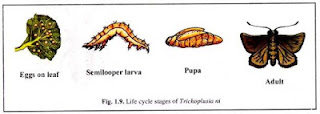Semi-looper Pest in Cotton Crop
Cotton Insect Pests Semi-looper
Common Name: Semi-looperLocal Name: Unt ali
Scientific Name: Anomis flava Fab.
Family: Noctuidae
Order: Lepidoptera
Pest Category: oliage feeder
Distribution and status: India, Africa, Asia & Australia.
Host range: Cotton, Tomato, Bhendi, and other Malvaceous plants.
Description of Insect Stages:
 |
| Semi-looper Life Cycle |
Egg:
Eggs are spherical, ribbed about 0.5 mm in diameter. They are deposited anywhere on the cotton plant.
Larva:
 |
| Semi-looper in Larva Stage in Cotton |
longitudinally on the dorsal flopper dorsal surface, and with Six pairs of black and yellow spots on the back. The larvae are usually found on the lower leaf surface and are most likely to be observed on the upper third of the plant.
Pupa:
 |
| Semi-looper in Pupa Stage in Cotton |
Adult:
The adult is reddish-brown with forewings traversed bytwo dark zigzag bands, while the hind wings are pale brown.
 |
| Semi-looper in Adult Stage in Cotton |
Nature of Damage:
An outbreak of Anomis Flava is often sporadic, The walking young larvae congregate in groups and move actively, feed on the leaf lamina making small punctures. The grown-up larvae feed voraciously leaving only the midrib and veiny feed by chewing the leaves from margin towards the leaf veins. The caterpillars feed on tender shoots, buds, and bolls, but occasionally.
- The young larvae congregate in groups and move actively, feed on the leaf lamina making small punctures.
- The grown-up larvae feed voraciously leaving only the midrib and veins.
- The caterpillars also feed on tender shoots, buds, and bolls.
Symptoms:
Leaf area is eaten up from edges. Windows/holes on leaves are seen. Blackface on the leaf surface is common. Larvae found amidst the terminal part of the plant and with looping movements.- Membranous leaves
- Skeletonised leaves
- Defoliation
- Holes on bolls and twigs.
Life History:
The fecundity of the female is about 500-600 eggs. Upon hatching the smaller larvae drop to older leaves and start feeding on the lower surface of the leaves. By mid growth, stage larvae become gross leaf feeders consuming all the leaf tissues. Life Cycle is completed within 28-42 daysManagement:
- Spray phosalone 35 EC @ 2ml/lit.










No comments